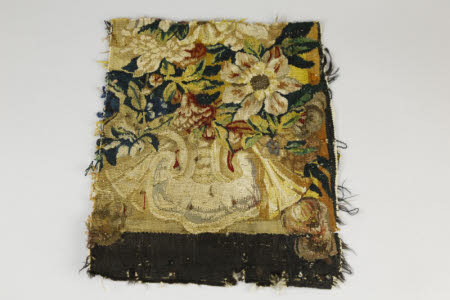Border Fragment
probably Lille
Category
Tapestries
Date
circa 1690 - circa 1703
Materials
Tapestry, wool and silk, 7 warps per cm
Measurements
0.24 m (H); 0.21 m (W)
Place of origin
Lille
Order this imageCollection
Dyrham, Gloucestershire
NT 454869.14
Summary
Tapestry, wool and silk, 7 warps per cm, Border Fragment from a set of Enghien Verdures, probably Lille, Jan de Melter or Willem Werniers, c. 1690-1703. A small fragment from the border of a tapestry with leaves and flowers on a light brown ground, and a strip of dark brown galloon at one side. This is one of 13 fragments and 6 large pieces from the set at Dyrham.
Full description
The six tapestries in the Tapestry Bedroom at Dyrham, and a related collection of fragments now kept in storage, are the part of a series of verdures with formal garden motifs. The surviving pieces would originally have formed at least five different hangings. The tapestries were described in a 1703 inventory of Dyrham as 'Enghien Tapistry Hangings', and as Anthony Mitchell has shown their designs are largely drawn from prints by Romeyn de Hooghe of the famous formal gardens at Enghien, south-west of Brussels (Mitchell, 1999). The Dyrham tapestries are not strictly copied from de Hooghe's engravings but they include some of the principal features of the gardens he depicted. These are set within lush foliage and trees of a type commonly found in late seventeenth century verdure tapestries, and some further garden elements are introduced that do not relate to the Enghien prints. The gardens were begun by the prince-comte Charles d'Arenberg (1550-1616), who bought the estate at Enghien in 1606, and work continued after his death by his wife Anne de Croy (1564-1635). However it was their sixth son, Antoine (1593-1669), who oversaw the creation of the gardens that we see in de Hooghe's engravings and in the Dyrham tapestries. The gardens were renowned throughout Europe in the late seventeenth century. William Blathwayte, who bought the tapestries for Dyrham, certainly knew of them, as his library contained '4 prints of Enghien with a book thereof... sheets in all 24' – possibly a book of de Hooghe's engravings (Mitchell 1999, pp. 34-36). The tapestries bear no makers' marks. Similar verdure tapestries were attributed by Heinrich Göbel to the Brussels weavers Jan de Melter (d. 1698) and his son in law Guillaume (or Willem) Werniers (d. 1738), and Wendy Hefford also observed that the style of the hangings is close to that of examples signed 'G Werniers'. In 1689 De Melter emigrated to Lille, a town which had been part of the Netherlands until 1667 when it was captured by the French. He was followed by Werniers, who married de Melter's daughter and took over his workshop in 1700, and registered as a citizen of Lille in 1703 (Mitchell 1999, p. 34; Delmarcel 1999, p. 339; Forti-Grazzini 1994, pp. 356-70). The tapestries at Dyrham had been made and delivered before 1703, when they appear in an inventory, and they could have been made by de Melter before his death in 1698, or by Werniers between 1698 and 1703. Aside from the tapestries at Dyrham, the largest surviving group of Enghien verdures is a set of six at Maiden Bradley, Wiltshire. This set was purchased in Paris in 1902 and has been significantly cut up to fit into the Dining Room of the house. Five of the Maiden Bradley tapestries share all or part of their designs with tapestries at Dyrham, allowing Anthony Mitchell to reconstruct a notional series of six designs across the two sets. Mitchell also lists seven further individual tapestries that have appeared on the art market during the twentieth century (Mitchell 1999, pp. 34, 37). An inventory of Dyrham Park in 1703 described 'three pieces of Enguien Tapistry Hangings' in the Tapestry Bed Chamber, and three were listed again in 1710. There are the remains of five different hangings at Dyrham today, and it is possible that the other two were not hung in the early eighteenth century, or that they were part of a set of 'Forest hangings' recorded in the Best Bedchamber. The set was subsequently moved and cut up more than once to fit into new spaces in the house, and in the nineteenth and twentieth centuries hung in the Tapestry Bedroom. The tapestries are recorded in this location in a 1906 photograph (Mitchell 1999, p. 33 and fig. 9, p. 37 [NB photo reproduced in reverse]). (Helen Wyld, 2012)
Provenance
Indigenous collection recorded at Dyrham in 1703; thence by descent; purchased by the Ministry of Works through the National Land Fund and transferred to the National in 1956 and given to Dyrham Park in 1961
Credit line
Dyrham Park, The Blathwayt Collection (acquired by the Ministry of Works via the National Land Fund in 1956, and transferred to the National Trust)
Makers and roles
probably Lille , workshop possibly Jan de Melter (fl.1679 - 1698), workshop possibly Willem Werniers (d. Lille 1738), workshop
References
Mitchell, 1999: Anthony Mitchell. ““La plus belle chose du monde' and the Enghien tapestries at Dyrham Park and Maiden Bradley.” Apollo April (1999): pp.33-37. Delmarcel, 1999: Guy Delmarcel, Flemish Tapestry, Tielt 1999 Forti-Grazzini, 1994: Nello Forti-Grazzini, Gli Arazzi (Il patrimonio artistico del Quirinale), 2 vols., Rome 1994
